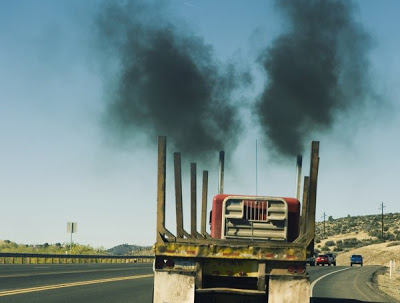Smokestack blues:
Confronting dangerous climate change
By Bruce Melton / The Rag Blog / November 24, 2010
Turkey AND Ham everyone! Excess carbon for all!
How do we curb emissions with the way our society has evolved? Really. I mean serious curbing; enough to prevent dangerous climate change?
Do you realize that ocean primary productivity has declined 40% since 1950? Or that, this year’s coral bleaching was worse than during the super El Nino of ’98? Or that, the Arctic was declared functionally ice free last summer for the first time in 14 million years?
Or that, the ultra high CO2 levels in prehistory were really only half as high as we thought, meaning we are a lot closer to the extreme paleohothouse environment than we thought? Or that, the dead trees from the pine beetle pandemic in Yellowstone are visible on Google and that the pandemic has begun its transition to the boreal forest in Alberta?
Or that, October 2010 was the 308th consecutive month with an average temperature above the 20th century average?
Unless we quickly find the ability to develop the magic sequestration machine, we are indeed relegated to experience dangerous climate change at least in our children’s lifetimes. By dangerous climate change, I mean the traditional scientific definition. Not, apparently, what 80 percent of Americans think.
What I mean is this: a climate change that creates global economic dysfunction. I mean what the scientists mean when they talk about dangerous climate change, A shift of our functional climate that results in significant sea level rise — dislocating hundreds of millions, maybe billions. This is the standard scientific definition of dangerous climate change that results in global ecoregime change that kills hundreds of millions with famine.
It doesn’t take long to change a grassland to a sea of sand — meaning that dry land agriculture can dry up in a megadrought in a few years. The extremeness of megadroughts, that have happened repeatedly in the ancient past, being 100 to 300 years in duration with only half of the rainfall that we received in the Dust Bowl.
Dangerous climate change changes Earth’s environment beyond the evolutionary niches of keystone species like primary productivity. When primary productivity takes a hit, not only does the most important part of Earth’s natural sequestration machine lose efficiency, but significant reduction in the efficiency of Earth’s oxygen generation machine takes place as well.
I don’t think the cost of prevention will be any more than Lord Sterns estimates at one to two percent GDP. I am also certain that any number of sequestration technologies are entirely feasible including clean coal… If, we act really soon.
How do I know that some 80% percent of Americans do not understand the definition of dangerous climate change? I don’t, but I do know that the recent Scientific American poll, a dataset that should reveal a higher level of education than most, reveals that these survey respondents would fail their Climate Change 101 class miserably. Only an eight-question survey, the telling question was #8. How much would you be willing to pay to forestall the risk of catastrophic climate change? The response was 79.6 percent for “nothing.”
Curiously, Scientific American has removed the link to this poll from their site. Survey Monkey, however, still has the data up, unidentified. I looked at Scientific American to confirm this a couple of weeks ago when one of my oldest friends, who has gone over to the dark side, verbally accosted me with this news (once again) of the death of the AGW Conspiracy. The other seven questions in the poll are just as telling as to the profound depth of the success of the propaganda and misinformation campaign of the vested interests as the last question.
[When Bruce Melton, P.E., isn’t practicing civil engineering, he’s studying climate change and writing about it. Melton was one of eight Austinites named in the “Heroes of Climate Change” article published in The Good Life magazine in July 2007. To read more of his work on climate change, visit his website, Melton Engineering Services Austin.]
- Also see “The Price of Change,” an op-ed by James Hansen on the potential of Chinese leadership to save the planet.
- And see other articles on climate science by Bruce Melton in The Rag Blog.


















